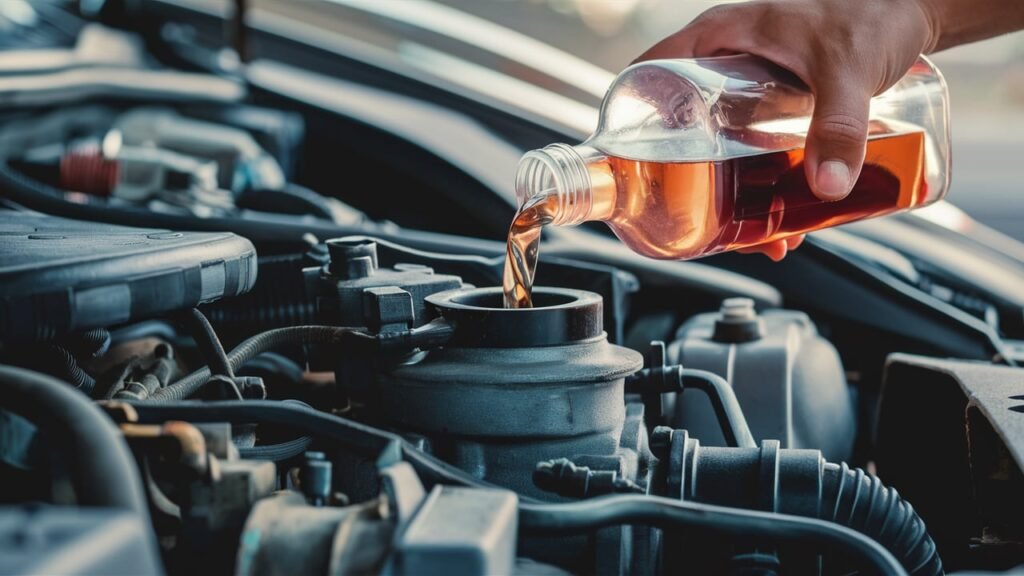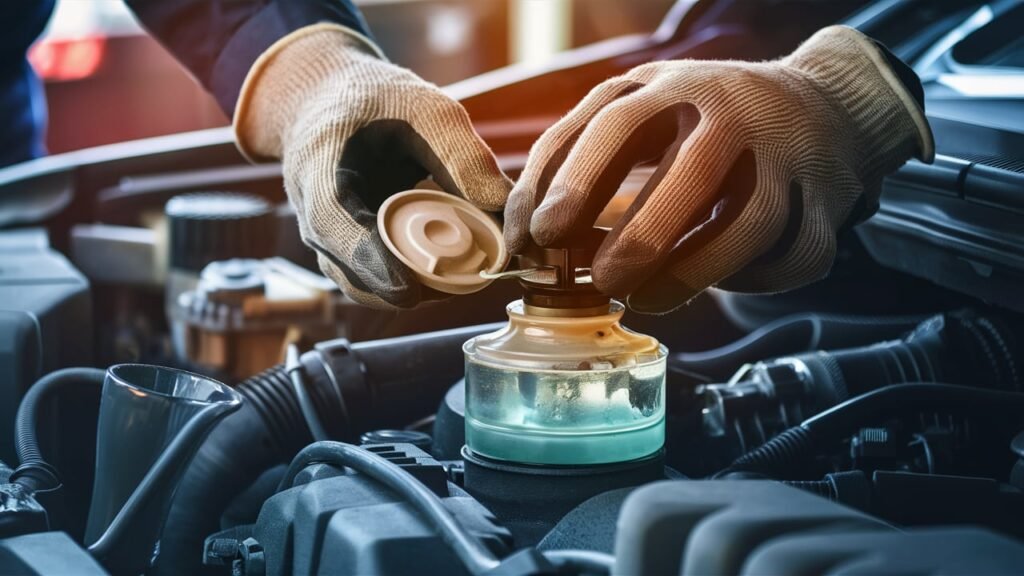
How to Maintain Car Engine Brake Fluid Levels
In the intricate ecosystem of a vehicle’s braking system, proper maintenance of brake fluid levels stands as a crucial pillar ensuring optimal performance and safety. As the unsung hero behind every effective stop, brake fluid plays a pivotal role in transmitting hydraulic pressure within the system, translating pedal force into stopping power with unwavering precision.
Imagine the repercussions of compromised brake fluid levels—the potential compromise in braking responsiveness poses not only a threat to the driver and passengers but also to fellow road users.
Delve with us into the meticulous realm of maintaining car engine brake fluid levels as we unravel the significance it holds within the heart of your vehicle’s safety architecture.
Akin to a conductor orchestrating a symphony, brake fluid choreographs seamless movement between various mechanical components like master cylinders, calipers, and pistons during each deceleration maneuver.
An oversight in monitoring these vital fluid levels could lead to disastrous consequences: diminished stopping distances risking collisions, uneven distribution of braking forces destabilizing handling dynamics, or worse—a complete failure jeopardizing lives on the road.
Diving beyond surface-level understanding unveils how this often-overlooked liquid safeguarding your vehicle’s proficiency operates silently yet mightily at every press of the pedal. Join us on an enlightening expedition into the core principles underpinning safe driving practices through meticulous attention to maintaining car engine brake fluid levels.
Understanding Brake Fluid.
Brake fluid serves as a crucial component within a vehicle’s braking system, tasked with transmitting force from the brake pedal to the brake components. Typically composed of glycol-ether and other additives, brake fluid is hygroscopic, meaning it readily absorbs water over time.
This feature enables the fluid to maintain its viscosity and boiling point under extreme conditions. Regular checks are essential because moisture accumulation can lower the fluid’s boiling point, potentially leading to decreased braking efficiency or even brake failure in severe cases.

It is paramount to ensure that the correct type of brake fluid is utilized for specific vehicles. Different vehicles have varying braking system requirements, necessitating compatible brake fluids based on their composition and operating temperatures. Using an incorrect type may compromise braking performance and cause damage to brake components over time.
For instance, high-performance vehicles typically utilize brake fluids with higher boiling points to withstand elevated temperatures generated during aggressive driving or track use. The importance of adhering to manufacturer recommendations regarding brake fluid types cannot be overstated as it directly impacts both safety and optimal performance.
Checking Brake Fluid Levels.
To begin the process of checking your car’s brake fluid levels, you will first need to locate the brake fluid reservoir. This reservoir is typically located near the driver’s side firewall under the hood.
It is a translucent plastic container with markings indicating minimum and maximum levels for the brake fluid. Some newer vehicles might have variations in design, but generally, you can identify it by following the brake lines from the master cylinder.
Once you have located the reservoir, follow these steps to visually inspect your brake fluid levels accurately. Start by ensuring that your vehicle is parked on a level surface and the engine is cold. Remove the reservoir cap carefully, as excessive exposure to air may cause moisture contamination.

Look at the level against the markings – if it’s below the minimum line, it’s time to top up. Remember that overfilling can also lead to issues due to heat expansion, so maintain a balance between minimum and maximum thresholds.
Checking when your vehicle is cold is crucial because braking generates heat that can expand fluids in hot engines, potentially giving a false reading of sufficient brake fluid levels when checked hot. By examining it cold, you get an accurate representation of how much fluid remains in reserve for emergency braking situations.
Regular checks in various temperature conditions offer a comprehensive picture of your system’s health, allowing you to catch any leaks or issues promptly before they escalate into safety hazards on the road.
Top Tips for Maintaining Brake Fluid Levels.
To keep your brake system functioning optimally, establish a regular schedule for examining and replenishing brake fluid. Setting specific intervals, such as every six months or following the manufacturer’s recommendations, ensures consistent upkeep.
A well-maintained brake fluid level contributes to better braking performance and extends the longevity of crucial components like calipers and cylinders.
For instance, envision a scenario where a vehicle undergoes heavy stop-and-go traffic daily; in such cases, more frequent checks might be necessary due to increased stress on the brake system.

Various environmental conditions can expedite brake fluid degradation, prompting the need for more frequent evaluations. Temperature extremes, especially high heat environments, can accelerate moisture absorption by the fluid, causing decreased effectiveness over time.
If you reside in regions with extreme temperatures or frequently encounter severe weather conditions during driving, consider inspecting your brake fluid levels more often to counteract premature deterioration.
Think of a vehicle operating in coastal areas where humidity is higher – the absorbed moisture in the brake fluid can lead to reduced boiling points and compromised braking efficiency.
When adding brake fluid to your vehicle, it’s crucial to prevent contamination that could harm the system. Before topping up the reservoir with fresh brake fluid, ensure cleanliness by wiping around the cap area to prevent debris from falling into the container.
Use a funnel specifically designated for brake fluid to avoid introducing impurities that could compromise braking performance. Imagine mistakenly mixing different types of fluids or using unclean tools – these errors could introduce air bubbles or contaminants into the system, potentially leading to unsafe driving conditions due to compromised braking capabilities.
Signs of Low Brake Fluid Levels.
When it comes to car maintenance, recognizing signs of low brake fluid levels is imperative for ensuring your vehicle’s safety and performance. One common indication of decreasing brake fluid levels is the sensation of spongy brakes.
If you notice that your brake pedal feels soft or mushy when you apply pressure, it could be a sign that your brake fluid is running low. This can occur due to air entering the braking system as a result of insufficient fluid.
Another symptom to watch out for is the illumination of warning lights on the dashboard specifically related to the brake system. Modern cars are equipped with sensors that detect irregularities in various components, including brake fluid levels.

If a warning light related to low brake fluid illuminates on your dashboard, it’s crucial not to ignore it as it indicates a potential issue that needs immediate attention.
Low brake fluid levels can have detrimental effects on various vital components within the braking system. The hydraulic nature of brake systems relies on an adequate amount of fluid to transmit force and safely stop the vehicle.
When levels drop too low, the effectiveness of this process is compromised, leading to reduced braking efficiency and potentially dangerous situations like extended stopping distances or even failure to stop altogether.
Prompt action is paramount when signs of low brake fluid are detected. Ignoring these indications can put you at risk while driving, jeopardizing both your safety and that of others on the road.
Failing to address low brake fluid levels promptly may lead to more severe damage within the braking system over time, resulting in costly repairs and compromised performance.
Therefore, if you observe any symptoms signaling low brake fluid levels, take immediate steps to rectify the issue for optimal safety and operational functionality.
Precautions and Safety Measures.
When handling brake fluid, it is paramount to adhere strictly to the manufacturer’s guidelines. Manufacturers specify the type of brake fluid suitable for each vehicle to ensure optimal performance and safety levels.
Using an incorrect type of brake fluid can lead to brake system malfunctions, compromising the car’s ability to stop efficiently. Moreover, following manufacturer recommendations for proper disposal helps prevent environmental contamination and reduces risks posed by hazardous waste.
Personal protective equipment (PPE) is essential when working with or near brake fluids. Gloves should be worn to prevent skin contact with the fluid, which can cause irritation or dermatitis due to its chemical composition.
Additionally, safety goggles are recommended to shield your eyes from splashes that could potentially cause harm. Ensuring proper ventilation in the working area when handling brake fluids further minimizes exposure and inhalation risks associated with their fumes.
Proper storage of unused brake fluid containers is crucial for longevity and safety reasons. Brake fluid containers should be tightly sealed after use to prevent moisture absorption, which can compromise the fluid’s efficacy over time.

Storing these containers in a cool, dry place away from direct sunlight maintains their integrity. It is also advisable to label containers clearly with the date they were opened to track their shelf life accurately and dispose of any expired products promptly.
By integrating these precautions and safety measures into your routine maintenance practices, you not only protect yourself but also contribute to sustaining your vehicle’s braking system efficiency and durability.
Prioritizing these guidelines ensures that you maintain a safe working environment while safeguarding your car’s overall performance on the road. Remember, attentiveness to such details is key in fostering a culture of responsible car maintenance among mechanics, car enthusiasts, DIYers, and automotive technicians alike.
Conclusion.
In conclusion, maintaining appropriate brake fluid levels in a car engine is paramount for ensuring vehicle safety and optimal performance. Brake fluid plays a crucial role in transmitting force from the brake pedal to the braking system, highlighting the necessity of regularly checking and topping up this vital component.
Proper maintenance of brake fluid preserves the integrity of the braking system, safeguarding against potential failures that could compromise driver and passenger safety.
I encourage all mechanics, car enthusiasts, DIYers, and automotive technicians to integrate routine checks of brake fluid levels into their standard vehicle maintenance practices. By prioritizing this aspect of car care, individuals can proactively address issues related to brake fluid degradation and prevent potentially hazardous situations on the road.
Remember, a simple inspection today can prevent more significant problems tomorrow, reinforcing the importance of vigilance when it comes to maintaining optimal car engine brake fluid levels.




